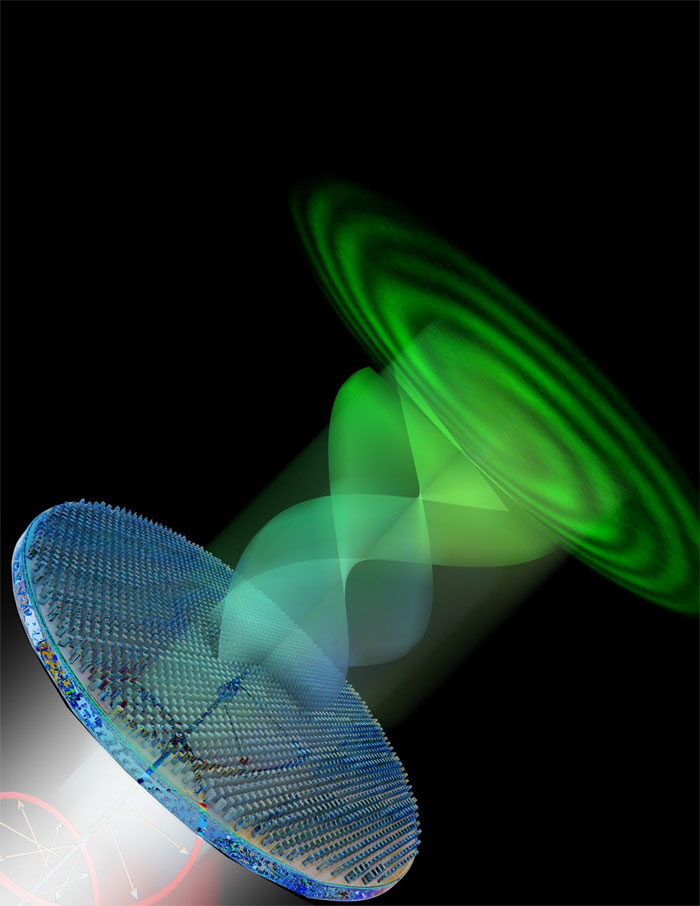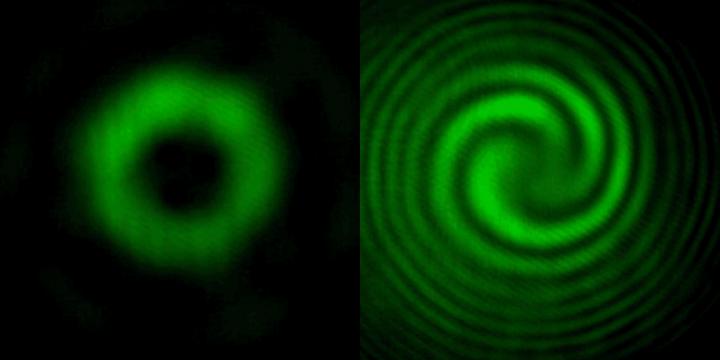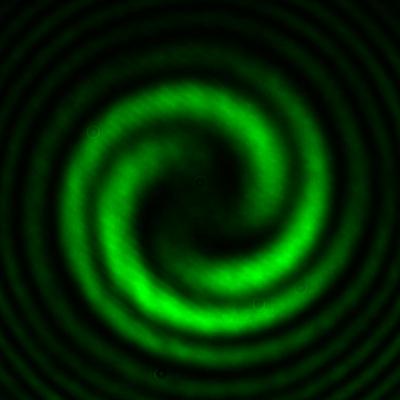Researchers have designed a method for converting arbitrary spin angular momentum (SAM) states of light into total angular momentum states. This method is characterized by the superposition of independent orbital angular momentum (OAM) and could lead to the generation of novel states of light for research and applications.

A metasurface uses circularly polarized light to generate and control new and complex states of light, such as swirling vortices. The tool can be used to develop new applications for structured light. Courtesy of Second Bay Studio/Harvard SEAS.
Researchers at the Harvard John A. Paulson School of Engineering and Applied Sciences (SEAS) developed a metasurface that converts left- and right-circular polarizations into states with independent values of OAM. The team designed an additional device that performs the same operation for elliptically polarized states. The research shows the potential for a material-mediated connection between the SAM and OAM states of light.
“We have developed a metasurface [that] is a new tool to study novel aspects of light,” said professor Federico Capasso. “This optical component makes possible much more complex operations and allows researchers to not only explore new states of light but also new applications for structured light.”
Using the metasurface, any polarization input can result in any OAM output. Thus, any polarization can yield any kind of structured light, from spirals and corkscrews to vortices of any size. The device can be programmed to produce one vortex from one polarization and a different vortex from another polarization.
“This metasurface gives the most general connection, through a single device, between the orbital momentum and polarization of light that’s been achieved so far,” said researcher Robert Devlin.
Arbitrary spin-to-OAM conversion of light could be used in optical communications and other applications that use structured light. One potential application is in the area of optical tweezers, which use light to move molecules. The orbital momentum of light is strong enough to make microscopic particles rotate and move.

A metasurface can generate strange new beams of light that swirl and corkscrew. The black hole in the center of these vortices can be used to image features smaller than half a wavelength of light or move tiny molecules. Courtesy of the Capasso Lab/Harvard SEAS.
“This is a completely new optical component,” said Antonio Ambrosio, principal scientist at Harvard Center for Nanoscale Systems (CNS). “Some metasurfaces are iterations or more efficient, more compact versions of existing optical devices, but this arbitrary spin-to-orbital conversion cannot be done with any other optical device. There is nothing in nature as well that can do this and produce these states of light.”
Another application could be in the area of high-powered imaging. The polarization of light could be adjusted to image features smaller than the diffraction limit.

Structured light, such as this corkscrewed beam, could tell scientists a lot about the physics of light and could have a wide range of applications from superresolution imaging to molecular manipulation and communications. Courtesy of the Capasso Lab/Harvard SEAS.
“You can imagine, if we illuminate the device with one polarization of light, it will create a force of a particular kind,” said Ambrosio. “Then, if you want to change the force, all you need to do is change the polarization of the incoming light. The force is directly related to the design of the device.”
The complex light structures generated by the metasurface could also be used to explore questions of fundamental physics.
“These particular beams are first and foremost of fundamental scientific interest,” said researcher Noah Rubin. “There is interest in these beams in quantum optics and quantum information. On the more applied side, these beams could find application in free-space optical communication, especially in scattering environments where this is usually difficult. Moreover, it has been recently shown that similar elements can be incorporated into lasers, directly producing these novel states of light. This may lead to unforeseen applications.”
The research was published in Science (doi: 10.1126/science.aao5392).